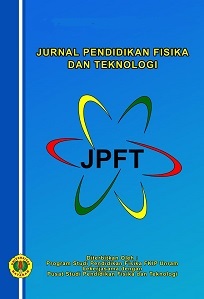Pengaruh Model Pembelajaran Problem Solving Laboratory Terhadap Hasil Belajar Fisika SMA Pada Materi Penerapan Persamaan Gerak Harmonis Sederhana
DOI:
10.29303/jpft.v7i2.3165Published:
2021-12-23Issue:
Vol. 7 No. 2 (2021): Juli-DesemberKeywords:
Problem Solving Laboratory, High School, Physics Learning OutcomeArticles
Downloads
How to Cite
Downloads
Metrics
Abstract
The purpose of this study are to determine whether there was a significant effect of the application of the Problem Solving Laboratory learning model on high school physics learning achievement and to identify improvements in high school physics learning achievement by using the Problem Solving Laboratory learning model. This research is a quasi-experimental research with non-equivalent control group design. The population of this study is the entire class X even semester of MA Al-Islamiyah 1 Sumber Batu Blumbungan Larangan Pamekasan, while the samples are 2 classes X IPA consist of 22 students each selected using purposive sampling technique. Based on the results of hypothesis testing using the Independent Sample T-test test in the SPSS V. 25 program, obtained a value ofÃÂ ÃÂ > ÃÂ (4.334 > 2.018) and a sig value (2-tailed) = 0.000 or < 0.05 so it can be concluded that there is a significant effect of application of the Problem Solving Laboratory learning model to high school physics learning achievements. The results of data analysis using the N-Gain test showed the N-gain value in the experimental class was 0.7823 or G > 0.7. Thus, it is concluded that the improvement of high school physics learning achievements using the Problem Solving Laboratory learning model is in the high category.References
Arisa, N., Johansyah, & Hanif, M. K. A. (2020). Keefektifan Model Pembelajaran Novick Terhadap Pemahaman Konsep Fisika Siswa SMK Negeri 17 Samarinda Materi Elastisitas dan Hukum Hooke. Jurnal Literasi Pendidikan Fisika, 1(01), 45ââ¬â55.
Azizah, N., & Edie, S. S. (2014). Pendekatan Problem Solving Laboratory Untuk Meningkatkan Kreatifitas Dan Hasil Belajar Siswa Kelas XI MA Al Asror Gunungpati Semarang. UPEJ Unnes Physics Education Journal, 3(3), Article 3. https://doi.org/10.15294/upej.v3i3.4328.
Ellianawati -, & Subali, B. (2010). Penerapan Model Praktikum Problem Solving Laboratory Sebagai Upaya Untuk Memperbaiki Kualitas Pelaksanaan Praktikum Fisika Dasar. Jurnal Pendidikan Fisika Indonesia, 6(2), Article 2. https://doi.org/10.15294/jpfi.v6i2.1119.
Fadli, A. R., Subiki, S., & Astutik, S. (2019). Pengaruh Model Pembelajaran Problem Solving Laboratory Terhadap Kemampuan Berpikir Kritis Fisika Siswa di MAN 2 Banyuwangi. Jurnal Pembelajaran Fisika, 8(2), 53ââ¬â58. https://doi.org/10.19184/jpf.v8i2.11138.
Hariani, F. (2014). Program Studi Pendidikan Fisika Jurusan Pendidikan Mipa Fakultas Keguruan Dan Ilmu Pendidikan Universitas Jember 2014. 7.
Hasnawati, -. (2006). Pendekatan Contextual Teaching Learning Hubungannya dengan Evaluasi Pembelajaran. Jurnal Ekonomi dan Pendidikan, 3(1), Article 1. https://doi.org/10.21831/jep.v3i1.635.
Kurdi, & Nuraini, F. (2019). Penerapan Student Centered Learning Mata Ajar Ilmu Kesehatan Pada Program Studi Penjaskes. Jurnal Forum Kependidikan, 28 (2).
Malik, A., & Handayani, W. (2015). Model Praktikum Problem Solving Laboratory untuk Meningkatkan Keterampilan Proses Sains Mahasiswa. 4.
Mukrima. (2016). Peningkatan Hasil Belajar Fisika Melalui Pendekatan Kontruktivisme dengan Metode Siklus Belajar Karplus pada Siswa kelas XI IPA 3 SMA Negeri 1 POLUT (Polungbangkeng Utara) Kab. Takalar. Universitas Islam Negeri Alauddin Makasar.
Sari, Suci Wulan, (2011). Pengaruh Model Pembelajaran dan Tipe Kepribadian Siswa Terhadap Hasil Belajar Fisika Pada SMP Swasta Di Kecamatan Medan Area Dalam. http://library.unimed.ac.id.
Srilisnani, Amin, A., & Yolanda, Y. (2019). Penerapan Model Pembelajaran Contextual Teaching And Learning (CTL) Terhadap Aktivitas Siswa Kelas X di SMA Negeri 5 Model Lubuklinggau Tahun Pelajaran 2018/2019. Silampari Jurnal Pendidikan Ilmu Fisika, 1(1), 60ââ¬â73. https://doi.org/10.31540/sjpif.v1i1.319.
Sudjana. (2005). Metode Statistika. Bandung: Tarsito.
Sujarwata, -. (2009). Peningkatan Hasil Belajar Elektronika Dasar II Melalui Penerapan Model Pembelajaran Problem Solving Laboratory. Jurnal Pendidikan Fisika Indonesia, 5(1). https://doi.org/10.15294/jpfi.v5i1.998.
Wieman, C., & Holmes, N. G. (2015). Measuring The Impact Of An Instructional Laboratory On The Learning Of Introductory Physics. American Journal of Physics, 83(11), 972ââ¬â978. https://doi.org/10.1119/1.4931717
Author Biographies
Chairatul Umamah, Universitas Islam Madura
Maisyatul Azkiyah, Universitas Islam Madura
Herman Jufri Andi, Universitas Islam Madura
Suprianto Suprianto, Universitas Islam Madura
License
Copyright (c) 2021 Chairatul Umamah, Maisyatul Azkiyah , Herman Jufri Andi , Suprianto

This work is licensed under a Creative Commons Attribution-ShareAlike 4.0 International License.
Authors who publish with Jurnal Pendidikan Fisika dan Teknologi (JPFT) agree to the following terms:
- Authors retain copyright and grant the journal right of first publication with the work simultaneously licensed under a Creative Commons Attribution License 4.0 International License (CC-BY-SA License). This license allows authors to use all articles, data sets, graphics, and appendices in data mining applications, search engines, web sites, blogs, and other platforms by providing an appropriate reference. The journal allows the author(s) to hold the copyright without restrictions and will retain publishing rights without restrictions.
- Authors are able to enter into separate, additional contractual arrangements for the non-exclusive distribution of the journal's published version of the work (e.g., post it to an institutional repository or publish it in a book), with an acknowledgement of its initial publication in Jurnal Pendidikan Fisika dan Teknologi (JPFT).
- Authors are permitted and encouraged to post their work online (e.g., in institutional repositories or on their website) prior to and during the submission process, as it can lead to productive exchanges, as well as earlier and greater citation of published work (See The Effect of Open Access).











